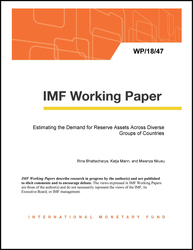
Estimating the Demand for Reserve Assets Across Diverse Groups
This paper takes a fresh look at the determinants of reserves holding with the aim of highlighting
similarities and differences in the motives for holding reserves among emerging markets (EMs),
advanced economies (AEs), and low-income countries (LICs). We apply two panel estimation
techniques: fixed effects (FE) and common correlated effects pooled mean group (CCEPMG). FE
regression results suggest that precautionary savings motives, both current account- and capital
account-related, are generally the most important determinants of reserves holding across country
groups and that their importance has increased for AEs and LICs since the global financial crisis while
receding for EMs. Mercantilist motives matter mostly for EMs. Intertemporal motives have been
gaining importance everywhere over time. The CCEPMG results confirm the importance of
precautionary motives and suggest that current account motives matter only for EMs and LICs and
capital account motives matter for all groups while being more important for EMs in both the shortand
long runs. The CCEPMG results also point to the importance of taking into account unobserved
common factors that affect coefficient estimates and the dynamic process through which reserves adjust
to changes. At about 0.6, the speed of adjustment to the long-run equilibrium implies that more than
half of the gap between actual and desired reserve holdings is closed within a year.
Publication date: March 2018
ISBN: 9781484345146
$18.00
Add to Cart by clicking price of the language and format you'd like to purchase
Available Languages and Formats
| English |
Prices in red indicate formats that are not yet available but are forthcoming.
Topics covered in this book
This title contains information about the following subjects.
Click on a subject if you would like to see other titles with the same subjects.
Panel data estimation , central banks , international reserves , financial crises
Also of interest
Summary
Copyright © 2010 - 2025
Powered by:
AIDC



